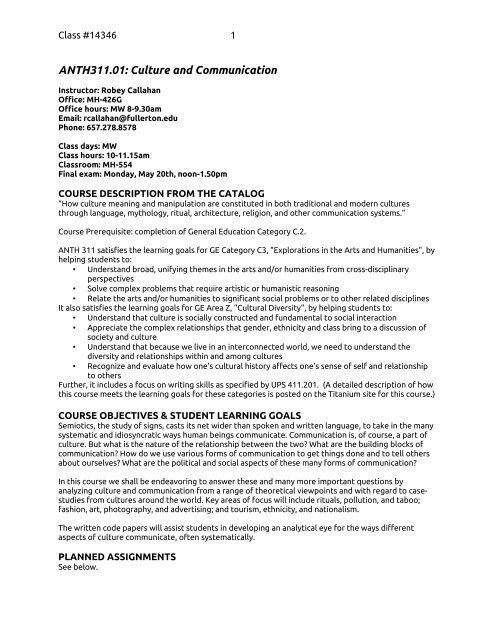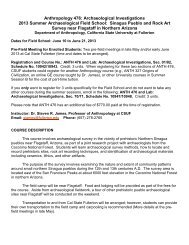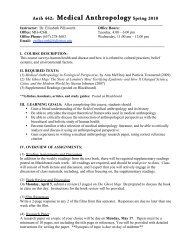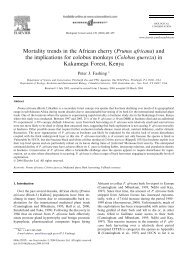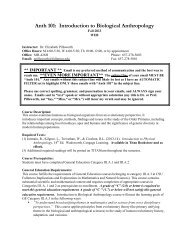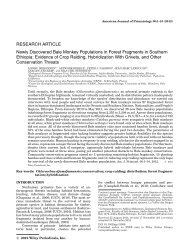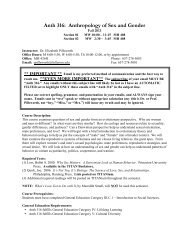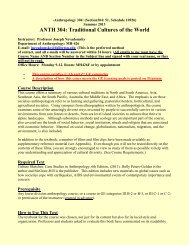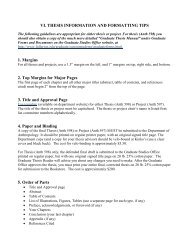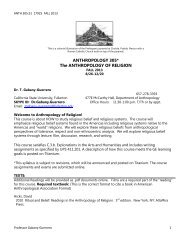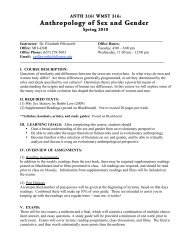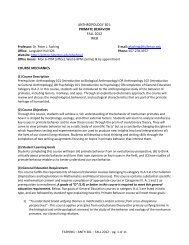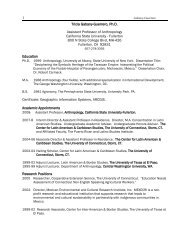Syllabus Template - CSUF Anthropology
Syllabus Template - CSUF Anthropology
Syllabus Template - CSUF Anthropology
You also want an ePaper? Increase the reach of your titles
YUMPU automatically turns print PDFs into web optimized ePapers that Google loves.
Class #14346 1<br />
ANTH311.01: Culture and Communication<br />
Instructor: Robey Callahan<br />
Office: MH-426G<br />
Office hours: MW 8-9.30am<br />
Email: rcallahan@fullerton.edu<br />
Phone: 657.278.8578<br />
Class days: MW<br />
Class hours: 10-11.15am<br />
Classroom: MH-554<br />
Final exam: Monday, May 20th, noon-1.50pm<br />
COURSE DESCRIPTION FROM THE CATALOG<br />
“How culture meaning and manipulation are constituted in both traditional and modern cultures<br />
through language, mythology, ritual, architecture, religion, and other communication systems.”<br />
Course Prerequisite: completion of General Education Category C.2.<br />
ANTH 311 satisfies the learning goals for GE Category C3, "Explorations in the Arts and Humanities", by<br />
helping students to:<br />
• Understand broad, unifying themes in the arts and/or humanities from cross-disciplinary<br />
perspectives<br />
• Solve complex problems that require artistic or humanistic reasoning<br />
• Relate the arts and/or humanities to significant social problems or to other related disciplines<br />
It also satisfies the learning goals for GE Area Z, "Cultural Diversity", by helping students to:<br />
• Understand that culture is socially constructed and fundamental to social interaction<br />
• Appreciate the complex relationships that gender, ethnicity and class bring to a discussion of<br />
society and culture<br />
• Understand that because we live in an interconnected world, we need to understand the<br />
diversity and relationships within and among cultures<br />
• Recognize and evaluate how one's cultural history affects one's sense of self and relationship<br />
to others<br />
Further, it includes a focus on writing skills as specified by UPS 411.201. (A detailed description of how<br />
this course meets the learning goals for these categories is posted on the Titanium site for this course.)<br />
COURSE OBJECTIVES & STUDENT LEARNING GOALS<br />
Semiotics, the study of signs, casts its net wider than spoken and written language, to take in the many<br />
systematic and idiosyncratic ways human beings communicate. Communication is, of course, a part of<br />
culture. But what is the nature of the relationship between the two? What are the building blocks of<br />
communication? How do we use various forms of communication to get things done and to tell others<br />
about ourselves? What are the political and social aspects of these many forms of communication?<br />
In this course we shall be endeavoring to answer these and many more important questions by<br />
analyzing culture and communication from a range of theoretical viewpoints and with regard to casestudies<br />
from cultures around the world. Key areas of focus will include rituals, pollution, and taboo;<br />
fashion, art, photography, and advertising; and tourism, ethnicity, and nationalism.<br />
The written code papers will assist students in developing an analytical eye for the ways different<br />
aspects of culture communicate, often systematically.<br />
PLANNED ASSIGNMENTS<br />
See below.
Class #14346 2<br />
GRADING POLICY FOR THE COURSE<br />
There is no extra credit offered in this course.<br />
This course consists of lectures and group projects. Attendance and participation are mandatory.<br />
• Every unexcused absence will harm your final grade by 3 full points, and this is not negotiable.<br />
• Every missed group project due to an unexcused absence will harm your final grade by a further 3<br />
points, and this is not negotiable either.<br />
Except under extraordinary circumstances, an absence counts as unexcused if a compelling excuse has<br />
not been provided to me within one week of that absence. This is not negotiable either.<br />
Paper (25 points): This paper is to be 1500-1600 words (not shorter and not longer). Although a general<br />
description of the paper is near the end of this syllabus, full details will be provided in class. Under no<br />
circumstances will this paper be accepted later than Wednesday, May 15th, in class. This is not negotiable<br />
either.<br />
Mid-term exam (35 points): This is a multiple-choice exam based on readings and lectures prior to it.<br />
Final exam (40 points): This is a multiple-choice exam based on all readings and lectures prior to it, but<br />
after the mid-term. It will include map questions from throughout the whole course (see About Maps<br />
below).<br />
This course is graded on a +/- scale:<br />
A = 94-100 points<br />
A- = 90-93 points<br />
B+ = 88-89 points<br />
B = 84-87 points<br />
B- = 80-83 points<br />
C+ = 78-79 points<br />
C = 74-77 points<br />
C- = 70-73 points<br />
D+ = 68-69 points<br />
D = 64-67 points<br />
D- = 60-63 points<br />
F = fewer than 60 points<br />
If an emergency prevents your attending a scheduled exam, you should contact me as soon as possible to<br />
discuss the possibility of a make-up exam.<br />
EXAMINATIONS<br />
Mid-term exam: Wednesday, March 27th, regular class period<br />
Final exam: Monday, May 20th, noon-1.50pm<br />
ABOUT MAPS<br />
<strong>Anthropology</strong> in general involves studying peoples from many different parts of the world. Having an<br />
idea of where on the map the various cultures we shall be discussing are (or were), will be of immense<br />
help to all students. Therefore, students will be asked to keep track, using a world map, of key<br />
locations. The final exam will have map questions from throughout the course (I shall tell you which<br />
places to remember!).<br />
REQUIRED TEXT<br />
This book should be available in the Titan Bookshop. A copy should also be on reserve in the library.<br />
Chandler, Daniel<br />
2007 Semiotics: The Basics. 2nd edition. London: Routledge.
Class #14346 3<br />
OTHER INSTRUCTIONAL MATERIAL/ACTIVITIES<br />
Readings available on Titanium (these are noted in the Course Schedule with an asterisk *):<br />
Anderson, Benedict<br />
1991 Imagined Communities: Reflections on the Origin and Spread of Nationalism. London:<br />
Verso.<br />
Douglas, Mary<br />
1966 Purity and Danger: An Analysis of the Concepts of Pollution and Taboo. London: Routledge.<br />
Geertz, Clifford<br />
2005[1972] Deep Play: Notes on the Balinese Cockfight. Daedalus 134(4):56-86.<br />
Goffman, Erving<br />
1963 Stigma: Notes on the Management of Spoiled Identity. New York: Touchstone.<br />
Hebdige, Dick<br />
1979 Subculture: The Meaning of Style. London: Mehuen & Co. Ltd.<br />
Leach, Edmund<br />
1964 Anthropological Aspects of Language: Animal Categories and Verbal Abuse. In New<br />
Directions in the Study of Language. Eric H. Lenneberg, ed. Pp 23-63. Cambridge, MA: MIT<br />
Press.<br />
Lutz, Catherine A. and Jane L. Collins<br />
1993 Reading National Geographic. Chicago: University of Chicago Press.<br />
Turner, Victor<br />
1969 The Ritual Process: Structure and Anti-Structure. Ithaca, NY: Cornell University Press.<br />
COURSE SCHEDULE<br />
Note: With the exception of the first class (obviously), all readings must be done prior to coming to class.<br />
Week 1: Monday, January 28th, and Wednesday, January 30th<br />
Introduction<br />
Chandler, xiii-xvi, 1-10<br />
Week 2: Monday, February 4th, and Wednesday, February 6th<br />
Saussure<br />
Chandler, 13-28<br />
Core Cultural Symbols: <strong>Anthropology</strong> as Semiotics<br />
* Geertz, Deep Play: Notes on the Balinese Cockfight, 56-86<br />
Week 3: Monday, February 11th, and Wednesday, February 13th<br />
Peirce<br />
Chandler, 29-47<br />
Week 4: Wednesday, February 20th<br />
Ambiguity I: Ritual Pollution and In-Between Spaces<br />
* Douglas, Secular Defilement, 29-40<br />
* Turner, Liminality and Communitas, 94-111<br />
Week 5: Monday, February 25th, and Wednesday, February 27th<br />
More Models of the Sign<br />
Chandler, 47-57<br />
Week 6: Monday, March 4th, and Wednesday, March 6th<br />
Ambiguity II: Stigma<br />
* Goffman, Stigma and Social Identity, 1-40<br />
Signs and Things I<br />
Chandler, 59-68
Class #14346 4<br />
Week 7: Monday, March 11th, and Wednesday, March 13th<br />
Signs and Things II<br />
Chandler, 69-82<br />
Ambiguity III: Animals...<br />
* Leach, Animal Categories and Verbal Abuse, 23-63<br />
Week 8: Monday, March 18th, and Wednesday, March 20th<br />
"Truth" in Advertising (A lecture with no assigned reading)<br />
Tropes<br />
Chandler, 123-145<br />
Codes<br />
Chandler, 147-173<br />
Week 9: Monday, March 25th, and Wednesday, March 27th<br />
Review for mid-term on Monday, March 25th<br />
Mid-term on Wednesday, March 27th<br />
Week 10: Monday, April 8th, and Wednesday, April 10th<br />
Fashion/Music<br />
* Hebdige, Subculture: The Meaning of Style, 100-127<br />
Paper explained and discussed<br />
Week 11: Monday, April 15th, and Wednesday, April 17th<br />
Textual Interactions I<br />
Chandler, 175-186<br />
Week 12: Monday, April 22nd, and Wednesday, April, 24th<br />
Textual Interactions II<br />
Chandler, 186-209<br />
Week 13: Monday, April 29th, and Wednesday, May 1st<br />
The "Other" I: Cannibal Tours (A film with no assigned reading)<br />
The "Other" II: National Geographic<br />
* Lutz and Collins, The Readers' Imagined Geographic: An Evolutionary Tale, 217-258<br />
Week 14: Monday, May 6th, and Wednesday, May 8th<br />
The "Other" III: Tourism and Ethnicity in Shetland (A lecture with no assigned reading)<br />
The "Other" IV: Census, Map, Museum... and Nation<br />
* Benedict, Census, Map, Museum, 163-185<br />
Week 15: Monday, May 13th, and Wednesday, May 15th<br />
Review for final<br />
Paper due on Wednesday, May 15th<br />
Finals week: Monday, May 20th, noon-1.50pm, is the final exam
Class #14346 5<br />
ANTH 311 - Culture and Communication<br />
CODE PAPER<br />
(25% of each student's grade)<br />
As noted in the <strong>Syllabus</strong>, this paper is to be 1500-1600 words (not shorter and not<br />
longer). This word-count range does not include the References Cited section. It only<br />
includes the Body Text itself.<br />
I. THEME<br />
You will be asked to analyze a code or codes that are of interest to you.<br />
We shall shortly be discussing various codes (music, typography, dancing, gestures,<br />
speaking, dress, etc) involved in late-1970s UK punk style. This should give you a place<br />
from which to start to think about the code(s) you would like to examine.<br />
There are hosts of other examples of codes from which students can choose. Some<br />
possibilities would include formal styles of greeting (eg, among the Wolof or among<br />
some other group), cars (eg, among American teenagers), buses (eg, among Pakistani<br />
or Guatemalan bus-owners), clothing styles (eg, among Christian or Buddhist monks),<br />
art styles (eg, in Renaissance Europe or in Islam), etc.<br />
Once a student has chosen his or her code(s), the task can be performed in one of two<br />
ways:<br />
1. A cross-cultural comparison of of apparently similar codes: the student can elect to<br />
work on a code present in American society (or some part of American society) and in<br />
some other part of the world. For example, a student can choose to look at how<br />
tattoos are used among Americans in the armed services versus how they are used<br />
among, say, the Maori of New Zealand. Or a student can instead choose to compare a<br />
code across two non-American cultures. For example, a student can examine the<br />
"code"-aspects of a cockfight, say, in Bali and in Brazil.<br />
2. A cross-code analysis: the student can take one code or sub-code as his/her central<br />
focus and then analyze how it relates to other codes (think here of the analysis of<br />
punk style done by Hebdige: here we see codes of music, clothing, writing and art<br />
forms, and dancing are all informed by each other). Although youth styles are rather<br />
easy to analyze in this way, the truth is that one can do a cross-code analysis in any<br />
culture and among any age group. The trick is here that certain core elements of<br />
meaning are expressed through a number of codes and form a sort of "signifying<br />
package" that stands out as recognizable from other such "packages".<br />
II. ORGANIZATION<br />
First off, the entire CODE PAPER should be double-spaced and in a standard 12-point
Class #14346 6<br />
font (such as Times Roman).<br />
Section 1: The Title Page<br />
Section 2: The Text Itself<br />
The Title Page is one page. It goes at the front of the paper. It contains<br />
the following information: Title of Paper (underlined), Name, Date, and<br />
Course Number.<br />
This section, following the Title Page, will contain no fewer than 1500<br />
words and no more than 1600 words.<br />
This section must be organized thus: an Introduction lets the<br />
reader know what is to come; Body Text provides the detail and<br />
the data; and a Conclusion tells the reader where he or she has<br />
been and what the meaning of it all is.<br />
All citations, as discussed below, must be noted in keeping with AAA<br />
Style (the AAA Style Guide is available as a PDF from Titanium).<br />
Having trouble with your writing? Seriously, the best place to get<br />
help is the Tutoring Center:<br />
http://www.fullerton.edu/ulc/TutoringCenter.asp<br />
Location: POLLAK LIBRARY NORTH, 2ND FLOOR<br />
Phone: 657.278.2738<br />
You have been advised of this!<br />
All citations, as discussed below, must be noted in keeping with AAA<br />
Style (the AAA Style Guide is available as a PDF from Titanium). If you<br />
have problems, you should ask at the Library, as they can help. You<br />
can also ask me, but it is best to start with the Librarians.<br />
Section 3: References Cited<br />
III. REFERENCES<br />
This section, following the Text Itself, will be formatted exactly<br />
according to the guidelines noted in the AAA Style Guide (which is<br />
available as a PDF from Titanium).<br />
The paper must cite a minimum of THREE ACADEMIC SOURCES. One of these three<br />
can be a reading from the course itself; the other two (or more) must be from outside<br />
the course. The paper can also have any number of POPULAR PRESS SOURCES, but it<br />
is essential that you know the difference here. For our purposes, an "academic"<br />
source is a peer-reviewed journal or book. A "popular press" source is anything that is
Class #14346 7<br />
not from a peer-reviewed journal or book.<br />
When looking for academic sources for your paper, the first place you may want to look<br />
is the "Going Further" section of Chandler (pp 235-241). It contains citations for<br />
academic sources organized in terms of themes. The bibliographic information for the<br />
sources can be found in Chandler's Bibliography.<br />
If you are in any doubt about either sort of source, please take this sheet along with<br />
the source in question to one of the Librarians at the <strong>CSUF</strong> Library. The Librarians can<br />
help.<br />
CRITERIA FOR GRADING<br />
Your grade for this assignment will be based on four main criteria. They are noted as<br />
follows:<br />
1. Grammar and Spelling (5 points maximum out of 25): Proper grammar and spelling<br />
are essential parts of any well-written paper. The categories for assessing grammar<br />
and spelling are as follows:<br />
Low: Serious and multiple errors in grammar and/or spelling make the paper<br />
difficult to comprehend. Little or no proof-reading is evident.<br />
Medium: Some errors in grammar and/or spelling weaken the paper but do not<br />
make it difficult to comprehend. This paper may have been proof-read, but not<br />
with as careful an attention to detail as is possible.<br />
High: Few or no errors in grammar and spelling allow the reader to focus more<br />
squarely upon the paper's content.<br />
2. Citation (5 points maximum out of 25): Students are expected to cite their sources<br />
properly. The citation format for this paper is that of the American Anthropological<br />
Association. The AAA Style Guide is available in PDF form on Titanium.<br />
Low: Proper citations are clearly missing or are not in AAA format.<br />
Medium: AAA format is used, but there are more than two errors in the use of<br />
that format.<br />
High: AAA format is used with two or fewer errors in the use of that format.<br />
3. Organization (5 points maximum out of 25): Students are expected to organize the<br />
paper as noted in the section on ORGANIZATION above.<br />
Low: The paper is difficult to follow. Perhaps it has no Introduction. Perhaps it<br />
is missing a Conclusion. Perhaps it is rambling.
Class #14346 8<br />
Medium: The paper has a recognizable Introduction, Body, and Conclusion, but<br />
one or more points mentioned in either the Introduction or Conclusion is not<br />
adequately dealt with in the Body; or perhaps there are serious continuity<br />
problems, with ideas expressed in one part failing to link clearly to ideas<br />
expressed in the following part.<br />
High: The paper is well organized. The Introduction leads us in nicely; the Body<br />
provides the evidence we need; and the Conclusion sums things up<br />
satisfactorily. Every sentence flows clearly into the next.<br />
4. Content (10 points maximum out of 25): Students are expected to approach this<br />
writing assignment intelligently and creatively and to link it to ideas expressed in the<br />
course.<br />
Low: There is little or no evidence the student put much thought into the<br />
project. The ideas expressed show little or no attention to the issues dealt with<br />
in class or the course readings.<br />
Medium: There are good ideas here, but the materials are not linked well to<br />
issues dealt with in class or the course readings; or the materials are in fact<br />
linked well to issues dealt with in class or the course readings, but the ideas<br />
behind the paper itself do not suggest much thought on the student's part.<br />
High: The student clearly thought a great deal about the project and linked it to<br />
issues dealt with in class or the course readings.<br />
If you have any questions about any aspect of the writing assignment, please ask me<br />
in class (as others may have the same question), before or after class, during my office<br />
hours, or via email or phone.<br />
Please note: THE PAPER IS DUE NO LATER THAN WEDNESDAY, MAY 15th, IN<br />
CLASS. No late papers will be accepted. This is not negotiable. Students can<br />
actually turn this in early—there is no reason to leave it until the last minute.
Class #14346 9<br />
Academic Misconduct/Integrity:<br />
Students who violate university standards of academic integrity are subject to disciplinary sanctions,<br />
including failure in the course and suspension from the university. Familiarize yourself with the<br />
academic dishonesty policy in the current student handbook or at<br />
http://fullerton.edu/senate/PDF/300/UPS300-021.pdf <br />
Violations of the University’s Academic Misconduct policies will not be tolerated. Studying and working<br />
together is encouraged, but all written assignments MUST BE YOUR OWN WORK. Fabrication of<br />
research data and/or plagiarism will result in a grade of “0” for the assignment.<br />
Disability Statement:<br />
DISABILITY STATEMENT: If you have a disability or special need for which you are or may be requesting<br />
an accommodation, please inform the instructor and contact the Disabled Student Services office,<br />
located in University Hall 101, as early as possible in the term.<br />
For more information contact Disabled Student Services Office: 657-278-3117<br />
www.fullerton.edu/disabledservices/<br />
On the Irvine Campus: Student Affairs 949-936-1650<br />
Emergency:<br />
Students should refer to http://www.fullerton.edu/emergencypreparedness/ep_students.html to<br />
familiarize themselves with actions they should take in the event of an emergency.
Class #14346 10<br />
Statement acknowledging the contents of the syllabus—your copy to retain<br />
By signing below, I, ___________________________________, acknowledge that I understand the contents<br />
(please print your name above)<br />
of the syllabus for this course (Class #14346, Spring 2013), including but not limited to:<br />
• The grading policy<br />
• The attendance policy<br />
• The participation policy<br />
• The deadlines for assignments<br />
Further, I understand that there is no extra credit offered in this course, and I will not request extra<br />
credit.<br />
Further, I understand that any form of special treatment as regards one student is unfair to all other<br />
students, and so I will not request any form of special treatment.<br />
Further, I understand that, if I have a question about the mechanics of the course, I am to check the<br />
syllabus first for an answer. If I cannot find the answer there, I am encouraged to ask the instructor<br />
before, during, or after class, or via email or phone, or during his office hours.<br />
Signature of student: __________________________________________<br />
Date: _________________________________________________________<br />
(This is your copy of the statement. Please retain it along with your syllabus. Once you have signed and<br />
dated the statement on the following page, please hand that page in to me.)
Class #14346 11<br />
Statement acknowledging the contents of the syllabus—the copy to turn in to the instructor<br />
By signing below, I, ___________________________________, acknowledge that I understand the contents<br />
(please print your name above)<br />
of the syllabus for this course (Class #14346, Spring 2013), including but not limited to:<br />
• The grading policy<br />
• The attendance policy<br />
• The participation policy<br />
• The deadlines for assignments<br />
Further, I understand that there is no extra credit offered in this course, and I will not request extra<br />
credit.<br />
Further, I understand that any form of special treatment as regards one student is unfair to all other<br />
students, and so I will not request any form of special treatment.<br />
Further, I understand that, if I have a question about the mechanics of the course, I am to check the<br />
syllabus first for an answer. If I cannot find the answer there, I am encouraged to ask the instructor<br />
before, during, or after class, or via email or phone, or during his office hours.<br />
Signature of student: __________________________________________<br />
Date: _________________________________________________________<br />
(Once you have signed and dated this statement, please hand it in to me.)


